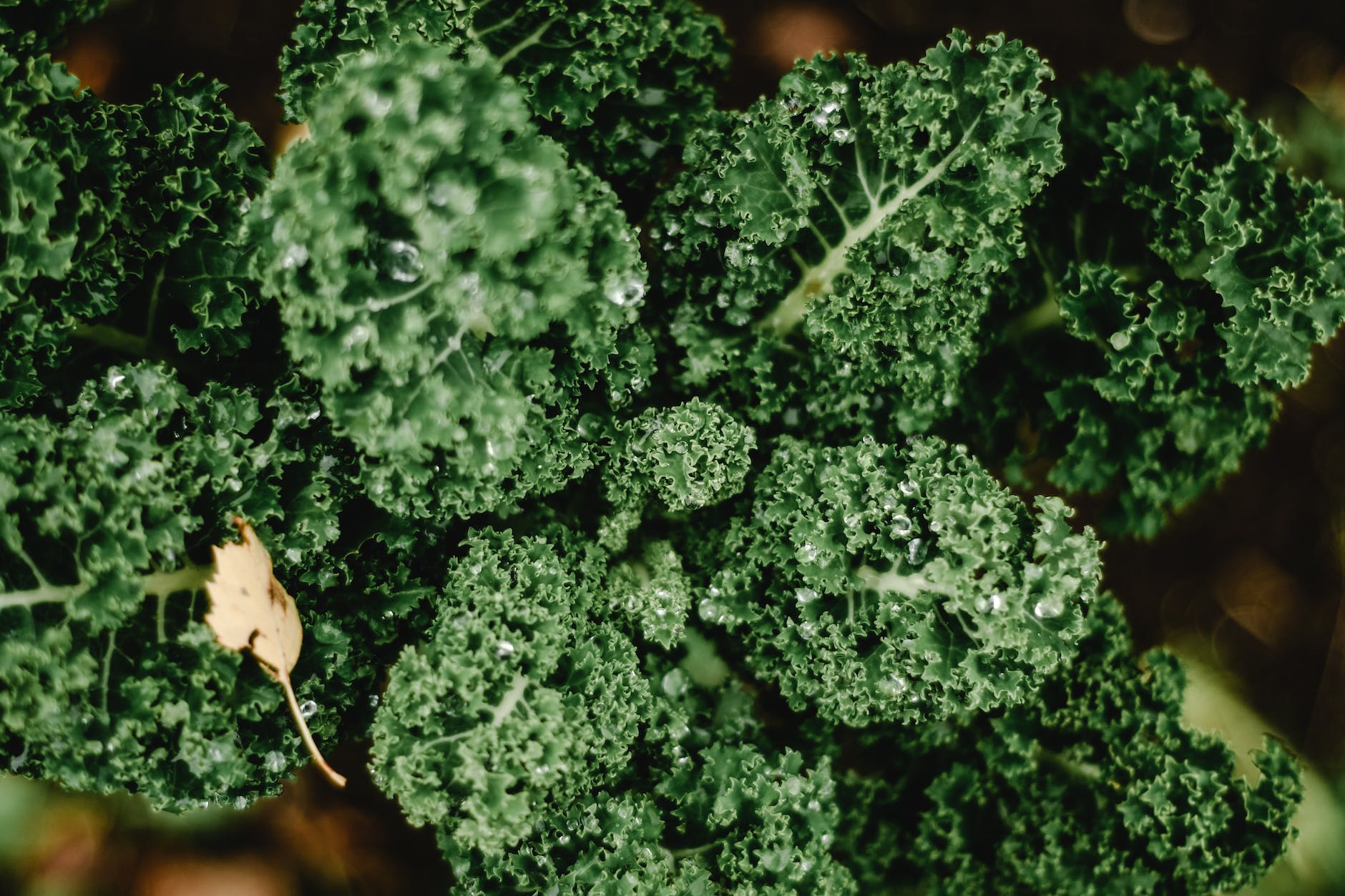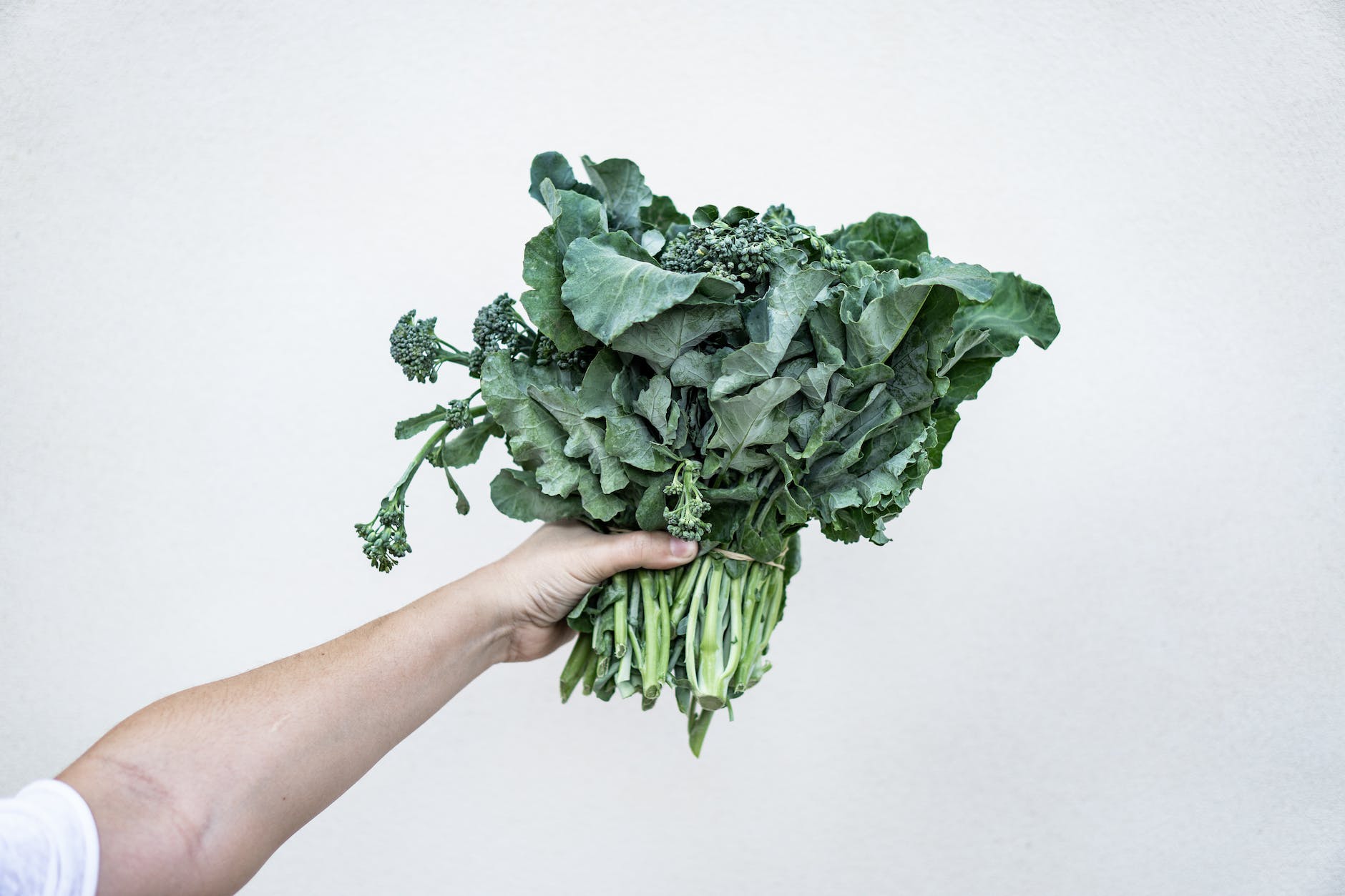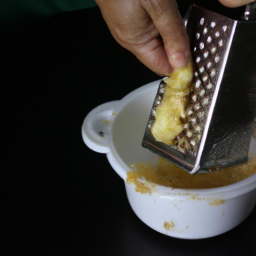The green, nutrient-rich leafy vegetable is filled with essential vitamins like A, C, K, B6, as well as manganese, copper, and potassium – all important components needed for the body to operate optimally. Kale is an excellent source of dietary fiber, which helps with regular digestion and weight management. Additionally, it provides a low-calorie option while still being packed with nutrients, making it an ideal choice for those looking to maintain their health without sacrificing taste or satisfaction.
Beyond these basic nutrients though there are many additional advantages of consuming kale regularly such as increased energy levels and better immune system function.
Additionally research suggests that adding kale into your diet could potentially reduce inflammation associated with chronic illnesses like arthritis. The rich antioxidant content found in kale may even protect against cancer cell growth too! All these properties make it clear why so many people turn to this powerhouse veggie when trying to improve their physical condition – but don’t forget about the potential benefits from drinking freshly made kale juice either!

Kale is a leafy green vegetable that’s gaining in popularity due to its nutritional benefits. It belongs to the Brassica family, which includes cabbage, cauliflower and Brussels sprouts.
There are many types of kale including curly kale, ornamental kale and dinosaur (Lacinato) kale. All varieties offer excellent nutrition with different textures and flavors. Kale can be eaten raw or cooked, alone or as part of recipes like salads, soups and smoothies.
The health benefits of kale include providing essential vitamins, minerals and antioxidants. One serving of fresh kale contains over 200% of your recommended daily intake for vitamin A and nearly 600% for vitamin K. It also supplies other nutrients like calcium, iron, fiber and potassium. Furthermore, consuming more fruits and vegetables such as kale may help lower cholesterol levels while reducing inflammation throughout the body.
Finally, there are lots of creative ways to incorporate this nutrient-dense superfood into your diet. From chips to pesto sauce to casseroles – you’ll find plenty of delicious ideas online or in cookbooks! With its versatility and growing availability in stores across the world, adding some kale into your meals is an easy way to boost nutrition without sacrificing flavor. As we move on from here let’s take a closer look at one specific benefit: the nutritional value of kale when consumed as juice…
Nutritional Value Of Kale
Kale is a nutritional powerhouse and its health benefits are vast. It’s packed with vitamins, minerals, fiber, protein, and antioxidants that can help support your body’s natural functions. Let’s take a look at the nutrient content of kale:
- Vitamins A, C & K
- Calcium
- Iron
- Potassium
- Magnesium
In addition to these essential nutrients, kale is also low in calories – just 33 calories per cup – making it an ideal choice for anyone looking to lose weight or maintain their current weight. The high fiber content helps you feel full longer and keeps your digestive system running smoothly. Plus, the combination of vitamins A, C & K make this superfood great for boosting immunity and protecting against free radicals.
When you consider all the nutrition facts about kale – from its vitamin and mineral content to its calorie count – it’s easy to see why so many people choose it as part of their daily diet. Not only does it provide essential nutrients for optimal health but it also tastes great when added to salads, soups or smoothies! Whether eaten raw or cooked, adding kale into your meal plan brings numerous health benefits without sacrificing flavor.
Health Benefits
Kale is a superfood that comes with numerous health benefits. From weight loss to improved immune system functioning, kale can help you feel your best. Here are some of the most noteworthy advantages of adding this nutrient-dense vegetable into your diet:
Weight Loss – Kale contains very few calories and plenty of fiber, making it an ideal food for those looking to lose weight. The high fiber content helps fill you up without overloading on calories or unhealthy fats.
Immune System Support – This leafy green is packed with Vitamin C which boosts immunity levels and helps keep colds away. Kale also provides vitamins A, E, and B6, helping ensure your body’s defenses stay strong when fighting off illnesses.
Heart Health – Eating more cruciferous vegetables like kale has been linked to lower cholesterol levels as well as decreased risk of coronary artery disease. Regularly consuming kale may reduce inflammation in the arteries while lowering blood pressure too.
Digestion Aid – Fiber binds water to soften stool, meaning it’s easier to pass through the intestines. Plus, regular consumption aids in digestion by stimulating intestinal peristalsis (wave-like contractions).
Cancer Prevention – Studies have shown that antioxidants found in cruciferous veggies such as kale help protect DNA from damage caused by free radicals – reducing one’s risk of developing cancer down the line.
Overall, including kale into your daily meals will provide plenty of nutritional benefits – improving both physical and mental wellbeing! Moving forward let’s look at different types of kale available today…
Different Types Of Kale
Kale is a superfood that comes in many shapes and forms. Like different colored paint on an artist’s palette, each type of kale has its own unique flavor and texture, making it a versatile vegetable to add to any dish. Just like snowflakes, no two types are exactly alike! Here’s a look at some of the most popular varieties:
Redbor Kale – With frilly edges resembling flower petals, Redbor kale is unmistakable with its deep purple-red color. Its mild taste makes it perfect for adding pizzazz to salads or lightly steaming as a side dish.
Lacinato Kale – Also known as dinosaur kale due to its dark green bumpy leaves, Lacinato kale has an earthier taste than other kales which lends itself well towards soups and stews.
Russian Kale – This variety of kale is slightly sweeter than others and can be used both raw and cooked. Russian kale does not become tough when cooked so it can easily be stir fried or sautéed.
Baby Kale – Baby kale leaves are much smaller than standard mature kale plants yet have the same nutritional value. It boasts a sweet flavor that pairs well with salads or smoothies for added nutrition without overpowering other flavors.
No matter what kind you choose, all types of kale offer amazing health benefits making them an ideal addition to your diet. Whether you want something crunchy or tender, bold or subtle, there is certainly a type of kale out there for everyone! From here we will explore how to prepare and cook this remarkable leafy green vegetable.
How To Prepare And Cook Kale
Preparing and cooking kale is easy. There are many ways to make it a delicious, nutrient-rich side dish or main course. It can be steamed, boiled, sautéed in olive oil, baked into chips, added to soups and stir fries, or eaten raw in salads.
When preparing kale for cooking, the first step is to remove any tough stems that may remain after washing. To do this, hold the stem at its base with one hand while using your other hand to pull away leaves from the stem until all of them have been removed. Afterward, roughly chop up the leaves before adding them to whatever recipe you’re making.
If you’re baking kale into chips, toss the chopped pieces in olive oil and season with salt and pepper before spreading them out on a baking sheet lined with parchment paper. Bake at 375 degrees Fahrenheit for 10-15 minutes or until they become crispy – stirring every few minutes so they cook evenly throughout! With these steps in mind, creating healthy recipes with kale will be simple enough for anyone to do.
Popular Recipes With Kale
Kale is one of the most versatile superfoods out there, and it has become a popular ingredient in many delicious recipes. It often gets overlooked as just being a garnish or an accessory to other dishes when in fact, kale can be used to create some truly amazing meals. To jumpstart your own culinary journey with this nutritious vegetable, here are five popular recipes that you can try at home:
| Recipe | Prep Time (min) | Cook Time (min) |
|---|---|---|
| Kale Smoothie | 5 | 0 |
| Kale Salad | 15 | 0 |
| Kale Chips | 10 | 30 |
| Kale Pesto | 20 | 0 |
| Kale Soup | 25 | 45 |
Let’s start off easy with something like a kale smoothie! All you need is some fresh kale leaves, some banana, almond milk and honey if desired.
Blend all the ingredients together until they’re smooth, pour into glasses and enjoy – takes no time at all and tastes great too! If you have more than 5 minutes to spare then why not attempt a delicious kale salad? Simply clean and tear up the kale leaves before adding them to chopped tomatoes, cucumbers, red onions and feta cheese with a tasty vinaigrette dressing.
Enjoying the crunchy texture of roasted vegetables? Then try out some homemade baked kale chips for a healthy snack option. Just preheat your oven to 375°F (190°C), mix olive oil lightly over torn kale leaves on baking sheets and bake for about 30 minutes.
For those who love Italian flavours, whip up some homemade pesto using ripped-up fresh kale instead of basil; blend garlic cloves, almonds/pine nuts/walnuts, Parmesan cheese with extra virgin olive oil until creamy before stirring through the drained pasta of choice for dinner.
Finally for soup lovers – nothing beats hearty vegetable broth made from sautéed onions & carrots with added potatoes & diced celery plus shredded pieces of steamed kale cooked in stock – doesn’t get much better than that! With these yummy options now available it won’t take long before you’ll be able to make these recipes by heart!
And once mastered why not move onto making your own batch of freshly squeezed natural juice right at home…
Making Kale Juice At Home
Making kale juice at home offers numerous benefits to those who enjoy the taste and nutrition of this superfood. Kale is nutrient-dense, containing vitamins A, C, and K as well as many minerals including calcium, magnesium and potassium.
Studies have shown that drinking freshly made kale juice can enhance overall health by boosting energy levels and improving digestion. Additionally, homemade kale juice has a greater concentration of nutrients than store-bought varieties due to the lack of preservatives or other added ingredients in its preparation.
When making homemade kale juice, it’s important to choose quality produce for maximum flavor and nutritional value. Opting for organic kale is highly recommended since it’s grown without pesticides or herbicides which could adversely affect the flavor of your finished product.
Using fresh fruits such as apples or oranges is also an excellent way to add sweetness and depth of flavor while providing additional key vitamins such as Vitamin C. There are countless variations of recipes available online using combinations of different fruits and vegetables so finding one that suits your palate should be relatively easy.
The process for juicing kale itself is quite simple; wash the leaves thoroughly before placing them into a juicer along with any desired fruit accompaniments. Depending on the type of juicer you use, some may require peeling before adding whereas others will accept unpeeled whole fruits like oranges or apples. After processing the mixture through your juicer according to manufacturer instructions, stir all ingredients together until blended evenly throughout then pour over ice if desired before serving immediately for optimal flavor retention.
Homemade kale juices offer an array of healthful benefits when consumed regularly – plus they’re incredibly delicious too! With just a few steps involved in their creation, making these beverages couldn’t be simpler – now let’s take a look at store-bought versions…
Store-Bought Kale Juices
Gone are the days when you needed to make your own kale juice in order to reap its nutritional benefits. Nowadays, store-bought kale juices from popular brands can be easily found in health food stores and supermarkets alike. But with so many different varieties available, it’s important for consumers to read labels carefully and understand what ingredients are being used.
Organic is always preferable, as these products tend to use higher quality ingredients of a purer source than non-organic options. It’s also important to check for added sugars or sweeteners that could undermine the healthy properties of the product. Additionally, look out for any preservatives or artificial flavors which can reduce nutrient content and affect overall taste.
When choosing a brand, strive for one that uses natural and organic ingredients while minimizing processing steps – this way you can ensure that you’re getting all the nutrition possible without sacrificing flavor. With careful consideration of these factors, store bought kale juices can serve as an excellent addition to any diet!
Side Effects
Despite the benefits of kale juice, it is important to be aware of potential side effects. Kale is a member of the Brassica family and may cause allergic reactions in individuals sensitive or allergic to other members such as cauliflower and Brussels sprouts. Symptoms can include itchiness, rashes, nausea, abdominal pain, vomiting and difficulty breathing.
In some cases, consuming too much kale can also lead to unpleasant symptoms including diarrhea and constipation. This is due to its high fiber content which if consumed excessively can irritate the digestive system leading to an upset stomach. Additionally, consuming large amounts at once has been associated with toxicity that causes fatigue, headaches and dizziness.
Therefore it is recommended to start slowly when introducing kale into your diet, incorporating only one serving per day while monitoring any adverse reactions that might occur. If you experience any unusual signs or sensations after eating kale consult a medical professional for advice on how to proceed safely.
Interaction With Medications
When it comes to kale, there is much to be said about its potential interaction with medications. As with any other food, it is important to consider the possible implications of consuming kale if you are taking certain drugs or supplements. It is also wise to consult your healthcare provider before adding more kale into your diet.
It has been suggested that eating large amounts of raw kale can interfere with some types of medications, such as blood thinners and thyroid hormones. This could potentially increase the risk for side effects or cause an irregular response in patients who take these drugs regularly. Additionally, some people have reported experiencing stomach discomfort after drinking large quantities of kale juice due to its high fiber content; this may affect absorption of certain medicines taken orally.
In general, caution should be used when introducing new foods like kale into a medication regimen since compounds within the plant can interact adversely with certain drugs or supplement regimens. When in doubt, always speak with your healthcare provider first about how adding more greens—like kale—to your diet might impact the effectiveness of any medications you’re on.
Frequently Asked Questions
What Is The Recommended Daily Intake Of Kale?
When it comes to eating kale, understanding the recommended daily intake is key. Eating too much or not enough can have an effect on your overall health and nutrition. With that in mind, let’s explore what the ideal amount of kale should be consumed each day.
The USDA recommends consuming 2-3 cups of leafy greens like kale per day for adults who are following a 2000 calorie diet plan. This means that if you’re looking to get the most out of kale’s nutritional benefits, then you’ll want to strive for around 1 cup (or 56g) of raw or cooked kale at least 5 times a week. However, this recommendation could vary depending on individual dietary needs and caloric intake requirements.
In terms of nutrients, one cup of chopped kale contains 36 calories with 3 grams of protein, 4 grams of fiber and zero fat—all while providing over 100% DV (Daily Value) vitamins A & K as well as seven other essential vitamins and minerals such as calcium and magnesium. Additionally, antioxidants found within kale help fight against free radicals which may lead to inflammation and disease prevention when eaten regularly as part of a healthy diet plan.
Overall, it is important to note that every person has different nutritional needs based upon age, activity level and lifestyle choices; therefore make sure you check with your doctor or dietitian prior to deciding how much kale should be included in your weekly meal plans.
Is Kale Juice More Nutritious Than Eating Raw Kale?
When it comes to nutrition, is kale juice more nutritious than eating raw kale? Eating a diet rich in nutrient-dense foods like kale and its juice can have numerous benefits. But when comparing the two forms of consumption, which offers greater nutritional value?
Nutritionists would agree that the cooked form of kale has slightly fewer nutrients than its raw counterpart. This means that if you want to reap the full range of health benefits from this superfood, you’ll need to consume it uncooked or lightly steamed. The reason for this difference lies in the fact that some vitamins are sensitive to heat and will break down during cooking processes. Therefore, consuming raw kale provides your body with all the essential vitamins and minerals it needs from this leafy green vegetable.
The nutritional profile of kale juice also differs from that of raw kale due to processing methods used by manufacturers. While drinking fresh cold pressed juice offers an array of micronutrients not found in other processed varieties, commercially packaged juices are often deprived of many beneficial properties found in their whole food counterparts. That being said, there is still merit in adding both forms into one’s daily routine as they each provide unique nutritional benefits: Nutrition Benefits Kale include fiber, folate, Iron & Calcium while Nutrition Benefits Kale Juice contain higher concentrations of antioxidants and phytonutrients such as flavonoids & polyphenols.
Ultimately, there isn’t one right answer as it depends on individual dietary needs and preferences – incorporating any form into your lifestyle may be beneficial for overall health. Whether you choose to eat it raw or drink it up – getting enough servings per day ensures your body receives adequate amounts of these key nutrients!
Does Kale Juice Have Any Additional Health Benefits?
Kale juice has been likened to a veritable super-elixir, promising everything from increased energy and improved digestion to better skin. But does it really have any additional health benefits beyond those of raw kale? Let’s take a look at what the research says about the health benefits of kale juice specifically.
When we compare eating raw kale with drinking its juice, it appears that both offer similar nutritional value – but there are some distinct advantages to drinking your greens. Kale juice is easier for our bodies to absorb than eating raw kale, as many of its nutrients are already broken down in liquid form; this means you can get more bang for your buck when consuming them through juicing. Additionally, because all parts of the plant are used in making the juice (including stems and leaves), much higher concentrations of beneficial vitamins and minerals can be obtained through consumption.
Studies suggest that regular consumption of kale juice may help reduce inflammation, boost immunity, improve heart health, lower cholesterol levels, aid weight loss efforts and even provide protection against certain cancers. It seems like every nutrient found in kale – including antioxidants such as Vitamin C & E , omega 3 fatty acids, carotenoids and polyphenols – contributes to these potential health benefits. Ultimately though, research shows that getting most or all of your daily servings of vegetables by way of juices is not an optimal long term solution; rather it should be seen as complementary to a balanced diet consisting mostly of whole foods.
It’s clear then that while there are certainly numerous nutritional perks associated with drinking kale juice regularly – if consumed responsibly – there’s no one miracle food or drink capable alone of singlehandedly providing us with complete nutrition. As always, moderation remains key when considering incorporating new elements into our diets!
Are There Any Special Storage Guidelines For Kale Juice?
Storing kale juice properly is essential for preserving its beneficial properties. With the proper storage guidelines, you can ensure that your kale juice retains its nutrients and remains safe to consume. From keeping it in the right temperature range to making sure the container is adequately sealed, there are a few key tips to follow when storing kale juice.
To start with, it’s important to keep your kale juice between 40-45 degrees Fahrenheit at all times. Refrigeration is best for maintaining such temperatures, however if you don’t have access to a refrigerator then using an ice pack or cool box might work as well. It’s also best not to store kale juice in direct sunlight or heat, so make sure you find a place that has consistent low temperatures before putting away your extract.
Airtight containers are also important when storing kale juice since air exposure can cause degradation of quality over time. Glass bottles are ideal for this purpose since they provide maximum protection from oxygen and other contaminants that could otherwise spoil the contents of your bottle. Additionally, be sure to check for any signs of mold growth within the container prior to consuming; if you notice anything unusual then discard immediately and replace with another container. Finally, try to use up your stored supply within seven days after opening – this will help prevent spoilage due to extended contact with air and light sources.
As long as you follow these storage guidelines carefully, you should be able to enjoy fresh kale juice without worrying about potential health risks associated with improper storage techniques. Remember: always double-check expiration dates on containers before drinking them!
Are There Any Potential Side Effects Of Consuming Too Much Kale Juice?
Understanding potential side effects of consuming too much kale juice is important, as overconsumption can lead to negative health impacts. While kale juice has many positive nutrition benefits, it’s essential to understand the risks associated with drinking too much of it. In this article, we’ll explore the dangers and consequences of excess consumption of kale juice.
The first thing to consider when looking at any food or beverage is its nutrient content. Kale juice contains a variety of vitamins and minerals that are beneficial for humans but in large quantities these nutrients may cause uncomfortable symptoms such as nausea or diarrhea. Excessive consumption could also potentially deplete your body’s stores of certain minerals like potassium, magnesium, and calcium which are all essential for good health.
Another issue to be aware of regarding too much kale juice consumption is that some components found in the juice have been linked to increased risk for kidney stones and other complications. Studies have shown that excessive intake of oxalates (a component naturally found in plants) from foods like spinach, chard, and even kale can contribute to stone formation if consumed in high amounts over time. It’s important then to assess how often you consume these types of juices and make sure not to exceed recommended guidelines set by experts.
In short, while there are many great nutritional benefits associated with fresh-pressed kale juice, it’s important to remember the possible adverse effects that come along with overconsumption – making moderation key when drinking it regularly. As always, consult a qualified healthcare professional before incorporating new dietary habits into your routine so they can best advise on what works best for you!
Conclusion
Kale is one of the most nutrient-rich superfoods on the planet. It’s packed with vitamins, minerals and antioxidants that can help protect your body from disease. With its high levels of dietary fiber and low calorie content, kale is a great addition to any diet.
It turns out that drinking kale juice has even more benefits than just eating raw kale. Kale juice contains higher amounts of certain nutrients such as Vitamin A, C, K and folate which helps boost overall health. Additionally, it may also have potential anti-inflammatory properties and be beneficial for digestion when consumed in moderate amounts.
The phrase “an ounce of prevention is worth a pound of cure” certainly applies here: consuming small amounts of kale juice regularly provides numerous long-term health benefits without having to worry about any adverse side effects. The key takeaway is this: adding some kale juice into your daily routine will give you an abundance of energy while providing essential micronutrients to keep you healthy and feeling good!
Hi, I’m Alexander. I’m a vegan of over 20 years, and I initially made the switch for health reasons. However, as time went on, I became more and more passionate about the ethical and environmental implications of leading a vegan lifestyle.
I am the author of The Graceful Kitchen, a vegan blog where I share recipes for delicious and nutritious vegan meals. As someone who is deeply committed to living a cruelty-free life, I am also a strong advocate for using whole foods as the foundation of a healthy diet – and believe that going vegan is one of the best ways to achieve this.










